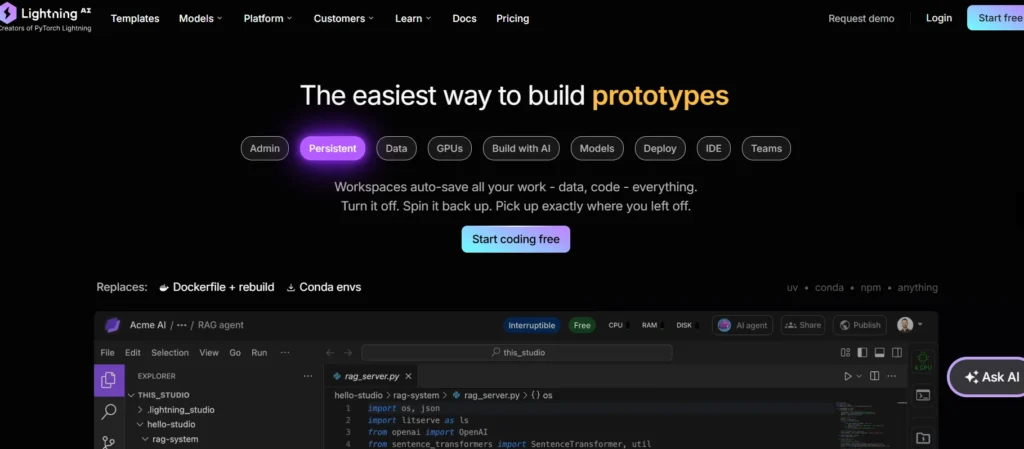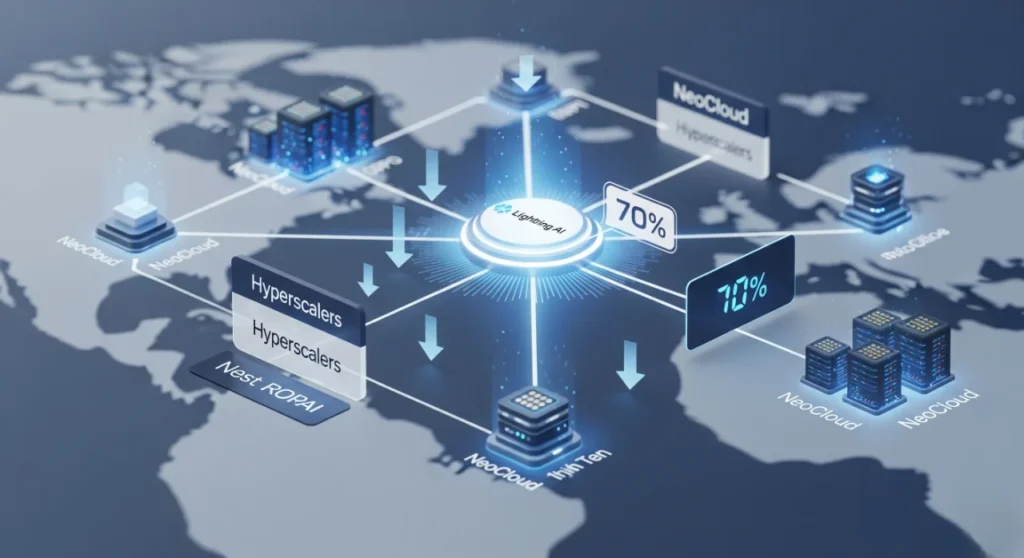Lightning AI just shook up the cloud market. The company unveiled the first Multi-Cloud GPU Marketplace, a single hub where AI teams can tap into hyperscalers and rising “NeoClouds”—with promises of cost savings up to 70%.
For years, developers faced tradeoffs between speed, flexibility, and price. Lightning AI says its new platform removes those barriers, giving startups and Fortune 500s alike a unified path to scale.
Key Takeaways
- Lightning AI debuts first multi-cloud GPU marketplace for AI teams.
- Platform integrates hyperscalers and new “NeoClouds” in one interface.
- Cost savings up to 70% claimed versus traditional GPU setups.
- No DevOps burden—supports SLURM, Kubernetes, or Lightning’s own system.
- Over 300,000 developers already use Lightning AI’s platform.
Lightning AI’s Multi-Cloud GPU Marketplace lets AI teams access GPUs from hyperscalers and “NeoCloud” providers in one platform. The company claims this can cut costs by up to 70% while removing infrastructure tradeoffs, giving developers flexibility, scale, and faster deployment without vendor lock-in.
Lightning AI Brings First Multi-Cloud GPU Marketplace
Lightning AI has launched a new Multi-Cloud GPU Marketplace, positioning itself as the bridge between big-name hyperscalers and a new wave of specialized compute providers called NeoClouds.
The company says the platform allows AI teams to slash infrastructure costs by up to 70% while gaining flexibility and eliminating lock-in—a pain point that has frustrated developers for years.

A Single Hub for GPU Power
Until now, teams often had to choose: hyperscalers with polished machine learning tools but steep prices, or smaller providers requiring heavy DevOps investment. Lightning AI’s marketplace consolidates those options into a single interface, already trusted by over 300,000 developers and Fortune 500 enterprises.
“This launch is about giving AI teams control, flexibility, and speed,” Lightning AI CEO William Falcon said in a press release. “Every customer has unique requirements, and our job is to support those workflows while helping them use their favorite cloud.”
Partnerships with Industry Leaders
Several cloud partners voiced support:
- Robert Brooks IV, VP of Revenue at Lambda:
“By combining Lightning AI’s development platform with Lambda’s reliability and scale, we’re empowering AI developers to build with confidence for the future.” - Laurelle Roseman, VP at Nebius:
“Together, we’re bringing teams the GPU performance and enterprise-grade reliability they need, with zero DevOps overhead.” - Daniel Bathurst, CPO at Nscale:
“European enterprises can now access secure, sovereign infrastructure directly through Lightning’s flexible AI platform.” - Saurabh Giri, CTO at Voltage Park:
“Our integration with Lightning AI brings our high-performance AI factory infrastructure seamlessly into the development workflow.”
These collaborations are intended to assure enterprise buyers that Lightning AI isn’t just a cost-saver but also a compliance- and performance-ready platform.
Choice Without Complexity
The marketplace supports both on-demand GPUs and reserved clusters, with orchestration via SLURM, Kubernetes, or Lightning’s own AI orchestrator. Teams can bring existing workflows without rewriting jobs or reconfiguring stacks.
That seamlessness may be the real draw. As CTO Luca Antiga noted:
“AI teams shouldn’t have to rebuild their entire stack every time they change providers. With Lightning AI, they don’t.”
Why It Matters
Infrastructure costs are often the make-or-break factor in AI adoption. With models growing larger and training cycles longer, a 70% cost reduction could expand access to advanced AI for smaller companies, research labs, and startups.
By enabling cloud-agnostic GPU access, Lightning AI reduces reliance on any single hyperscaler, offering transparency and choice at a moment when AI budgets are under scrutiny.
Reader Impact
For everyday readers and small businesses, this shift could mean cheaper AI-powered services—from smarter customer support tools to more personalized apps. With lower infrastructure barriers, more startups can compete, potentially driving faster innovation into consumer products.
Numbers to Watch
- 70% — claimed infrastructure cost reduction with Lightning AI’s marketplace.
- 300,000+ — developers already using Lightning AI’s platform.
- $150B+ — projected global AI infrastructure spend by 2028 (Statista).
What’s Next
- Expansion of Lightning AI’s marketplace into Asia-Pacific and Latin America.
- Tighter compliance integrations for European enterprises.
- Potential partnerships with GPU chipmakers like NVIDIA and AMD.
- Enterprise adoption signals as Fortune 500s test the platform.
Conclusion
Lightning AI’s GPU marketplace could reshape how AI is built—removing barriers that slowed down startups while giving enterprises a new way to optimize costs.
If the company delivers on its 70% cost-cut promise, this launch could mark a turning point in cloud competition and AI infrastructure democratization.
The open question: will hyperscalers embrace or resist this new layer of choice?
